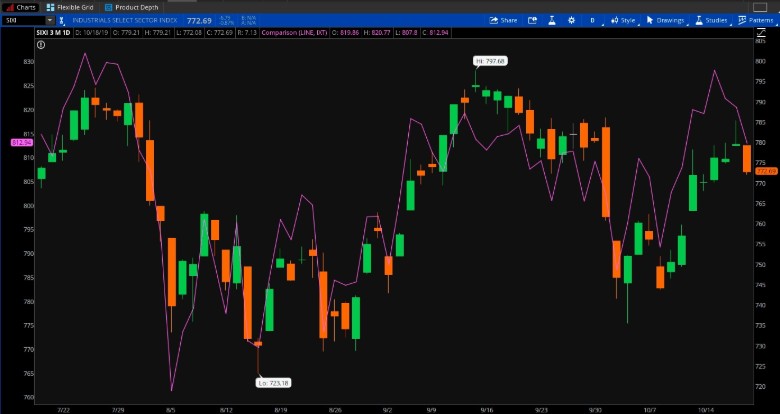(Monday Market Open) So far, red hasn’t colored October the way it did last year, but the hunt for an elusive 3000 in the S&P 500 Index (SPX) continues after the market couldn’t get its head above that particular wave last week.
The next five days are packed on the earnings beat, with about a quarter of S&P 500 companies due to report. So far, things have gone pretty well, but it’s still early. A little more than 14% of S&P 500 companies have reported through Friday, FactSet data shows. Of those, 81% posted earnings that beat third-party consensus expectations.
So that means we’ll be 40% done with earnings by the end of this week, giving investors a decent feel for how Q3 went. The season started with analysts expecting a 4% year-over-year earnings drop, but maybe things won’t turn out so badly. We’ll have to wait and see.
Remember, though, that it’s important to not get carried away so early in the game. If analysts are right, this would be the third-straight quarter of earnings declines. It’s hard for the “P” to go up in price-to-earnings when the E is going down.
When it comes to earnings reports, consider keeping a close eye on revenue, and not just on earnings per share. Keep in mind that companies can make adjustments around EPS to have them look more palatable. Revenue isn’t something they can tinker with. It’s either there or it’s not.
Despite all the negative talk going into the season, it seems like market participants are relatively happy so far with the early showing. You can arguably see that in the S&P 500 Index’s (SPX) ability to stay in the neighborhood of 3000 despite some pullback on Friday. Last week, the SPX rose 0.5% and the small-cap Russell 2000 led all indices with a 1.5% gain.
Earnings season really takes off (literally) this week with several major airlines reporting along with Boeing (NYSE:BA) and Lockheed Martin (NYSE:LMT). However, today is a bit light on the earnings calendar. The biggie this morning was energy company Halliburton (NYSE:HAL), but tomorrow is when the fun really starts with LMT, McDonald’s (NYSE:MCD), Biogen (NASDAQ:BIIB), and United Technologies (UTX) all before the open.
HAL, by the way, saw shares essentially go unchanged in pre-market trading as earnings met expectations but revenue came up a bit short.
Two traditional caution signs for the stock market—Treasury yields and volatility—remained in check at the end of last week. The Cboe Volatility Index (VIX) stayed under 15, which is well under highs of 20 seen earlier this month. In addition, 10-year Treasury yields are barely nudging, stuck roughly at the mid-point of recent highs and lows at 1.75%. We’ll see if either of these markers start to provide more direction as the week continues.
Straight Ahead: Fed And Brexit
Beyond the immediate prospect of earnings, two big events start to loom large as the month rolls along. By the end of next week, we could know the final score for Brexit and we’ll definitely have new word from the Fed. Until then, the market could be nervous and unlikely to break out of its long-term range as investors await the outcomes.Confused about Brexit and how it might affect things? You’re not alone. We’ve never had anything like it before, so there’s no playbook here. That’s one reason it’s hard to tell if the market is pricing in anything big one way or the other. Events over the weekend, with prospects of another delay, didn’t really do much to blow the clouds away. It seems like anything, including a “no-deal Brexit,” remains possible with the Oct. 31 deadline just 10 days away.The other thing that’s a lot less foreign to investors but also could keep the market in check is next week’s Fed meeting. Odds of another 25-basis point rate cut (the third since July) rose to 92% this morning—up from 73% a week ago—according to the Fed funds futures market. So that’s not really in much doubt. What could be interesting is to see how the Fed comes out of that meeting looking ahead to December. The China trade situation also keeps chugging along, and like Brexit, is still hard to predict. With earnings front and center this week, it’s possible the constant flow of headlines and tweets around trade might take a back seat. That said, you never know when something big might pop up and volatility might flare.
Old Week Ended On Amber Note
Friday was one of those days that could fool you if you don’t pay close attention. The Dow Jones Industrial Average ($DJI) fell nearly 1% as more controversy about Dow components Boeing (NYSE:BA) and Johnson & Johnson (NYSE:JNJ) weighed heavily. The much broader SPX fell less than 0.4%, and is probably a better way to judge how the day turned out.
Entering the new week, the SPX remains about 14 points under 3000, a level it peaked over briefly last week but hasn’t closed above in more than a month. The all-time intraday high of just under 3028 recorded back on July 26 hasn’t been tested in any meaningful way since mid-September. While it’s not necessarily out of the question, it would be pretty surprising to see that happen in the next two weeks, considering confusion over the status of “phase one” of a China trade deal, plus Brexit and the Fed coming up.
Judging by the mild gains in stock futures before Monday’s open, it seems like investors are wading cautiously into the week hoping for the best.

FIGURE 1: LET’S STICK TOGETHER: Both S&P 500 Industrials (SIXI-candlestick) and Technology sector stocks (IXT-purple line) have traded pretty much in sync over the last three months. Companies from these two sectors dominate the earnings calendar this week, so we’ll see if any divergence develops. Data Source: S&P Dow Jones Indices. Chart source: The thinkorswim® platform from TD Ameritrade. For illustrative purposes only. Past performance does not guarantee future results.
Earnings Spread Wings: If last week was all about the banks, this week it’s all over the place as far as earnings. There’s arguably no one sector that stands out, though you could argue Technology has a place at the front of the line with Microsoft (NASDAQ:MSFT) and Intel (NASDAQ:INTC) on the calendar. The Industrial sector comes into focus in a big way with LMT tomorrow and BA and CAT on Wednesday, and don’t forget the consumer when we get a look at McDonald’s (NYSE:MCD) and Procter & Gamble Company (NYSE:PG). We can get a sense of air travel demand with Southwest Airlines Company (NYSE:LUV) , American AIrlines (NASDAQ:AAL)), and Alaska Air (ALK) all on the docket. Then there’s the chance for a back door look at housing, so to speak, with Sherwin-Williams (NYSE:SHW) on Tuesday. Paint sales often point toward how many people are doing home renovation projects and how many contractors and home builders are spreading coats on new homes.
Early Results Appear to Confirm Two Trends: There was so much nervousness coming into earnings season about what the results might bring, but there is some happiness that results so far have been pretty good. What the results to date have really done is two things: Show that the Financials are incredibly resilient, and confirm that the consumer is ridiculously healthy. Whether the next few weeks continue to send the same message is anyone’s guess, but that’s why the market opens every day.
Some of the earnings calls to consider paying close attention to this week, besides BA—which should be interesting for the 737-MAX update—include Caterpillar (NYSE:CAT) and Intel (NASDAQ:INTC). Both of those could give insight into the China tariff situation, and INTC also offers a look into the chip sector, where stocks have been on a roll but demand concerns haven’t gone away.
Leadership Matters: Friday’s sad news about the death of Oracle (NYSE:ORCL) co-CEO Mark Hurd just a month after he’d taken a medical leave reminds investors not only how unpredictable life can be, but also why it’s not a good idea to pick a stock based only on the company’s leadership. If you admire a certain CEO, you can’t always be sure he or she will be there for the long run. For anyone buying an individual stock and intending to hold it a while, it’s important to choose based on the underlying company and industry fundamentals, as well as the entire executive team rather than one person.
Sometimes the death of a key executive can hurt a stock, though it’s unclear if ORCL’s losses Friday were related to Hurd’s death or part of a broader market selloff. However, if you own a stock and the CEO dies, that doesn’t necessarily mean it’s time to sell. Think back to the death of Apple (NASDAQ:AAPL) co-founder and CEO Steve Jobs in 2011. At the time, a lot of people worried the company wouldn’t be the same and the stock wouldn’t recover. Instead, shares of AAPL have almost quadrupled since then. That doesn’t mean there’s any way to predict the same for ORCL, only a reminder that it’s not all about an individual.
Good Trading
